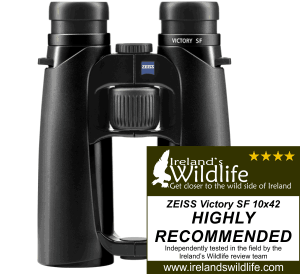 Pros: Exquisite image across an expansive and immersive field of view. Bright, clear and razor sharp… the Victory SF is optically up there with the best binoculars I’ve ever used. Superb balance, comparatively light weight and excellent overall build quality make for a compelling all-round package.
Pros: Exquisite image across an expansive and immersive field of view. Bright, clear and razor sharp… the Victory SF is optically up there with the best binoculars I’ve ever used. Superb balance, comparatively light weight and excellent overall build quality make for a compelling all-round package.
Cons: Even for an “alpha” class binocular the c. €2,500 price tag is eye-watering. Plastic eye-cups are a surprise on a binocular at this level, and the whole unit is a bit on the big side. Those lengthy barrels make for ergonomics that, while comfortable, take a little adjustment.
Price: RRP. c. €2,462.45 (GB£2,164.99)
Value: Good
Rating: Highly Recommended
As a flagship binocular from one of the “Big 3” European premium optics manufacturers the Zeiss Victory SF has a lot to live up to. It certainly does that on the optical front, and the ergonomics, balance and build quality are all up there too. This is a superb binocular — and optically at least matches those sharing the rarified air at the top of the optics tree.
If you’re in the happy position on shopping in the upper echelons of the optics market then the ZEISS Victory SF is probably already on your comparatively short short-list. If it’s not, then it probably should be.
View details of and buy the ZEISS Victory SF directly on the ZEISS UK website.
You can also buy the Zeiss Victory SF via Amazon.co.uk or on Amazon.com here.
ZEISS Victory SF 10×42 Binocular: Full Review
Reviewing a flagship binocular from one of Europe’s leading optics brands is always exciting, so when I learnt that ZEISS was sending the latest incarnation of its top-tier Victory line in for review I couldn’t wait to get my hands on them.
Balance, handling and build quality
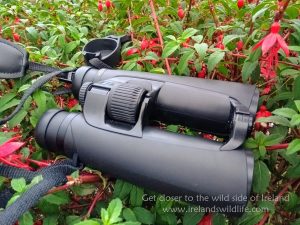 As you’d expect of a German made precision optical instrument from a company of ZEISS’s pedigree, the Victory SF is an extremely well put together piece of equipment.
As you’d expect of a German made precision optical instrument from a company of ZEISS’s pedigree, the Victory SF is an extremely well put together piece of equipment.
The use of premium grade components throughout (with one possible exception… see section on eye cups below), and an obvious attention to detail, results in a binocular that looks, feels and handles like a premium product.
Some reviewers complained that the earlier incarnation of the Victory SF, the one with grey rubber armour, perhaps didn’t meet the exacting build quality you’d be entitled to expect when paying a premium for a top-tier European manufactured binocular. If that’s the case it looks like ZEISS has paid attention, because there seems to be little to complain about with the build quality of this newer all-black incarnation of the Victory SF. The magnesium alloy housing is strong and light, and is covered with a subtly textured black rubber armour that is hard… but just yielding enough to afford comfort and grip. Everything feels solid and all the mechanics turn, pivot and twist the way they should.
One of the first things you notice about the Victory SF, apart from the improbably large box ZEISS ships it in, is how long the binocular is. The designers certainly weren’t going for compact when they put this baby together. So the Victory SF is big, even for a full size binocular, but it’s not as heavy as I expected it to be considering its bulk. It weighs in at a shade over 780g, which is average enough for a high quality 42mm binocular, and yet it handles and feels like a lighter instrument.
That’s down to the design of the optical system, by all accounts. The Victory SF sports longer barrels, allowing a less complex and therefore less heavy objective lens make-up, along with a complex wide-angle eyepiece design with more weight than usual. Together they serve to deliver a class-leading wide field of view, but they also shift the binocular’s centre of balance back towards the eyepiece. When you’re gripping the barrel between the open-bridge hinges, your index finger naturally falls on the focus wheel (situated right in the middle of the top hinge — a lovely piece of design), and the binocular sits in your hands in almost perfect balance. It feels like it’s not even there, and that makes the Victory SF one of the most comfortable binoculars I’ve ever used… as long as I’m holding it in the right place.
Back to those long barrels again.
I use binoculars a lot… but with the exception of massive porroprisms designed for tripod mounting, never any as long as these. Thanks to habit and ingrained “muscle memory”, when I reach for the Victory SF I invariably end up holding the binocular slightly too far up its lengthy barrels … and have to re-adjust by sliding my hands down to find the point of balance. There are no thumb-indents in the rubber armour on the underside of the Victory SF, which would help to guide your hands to the best spot.
It’s a minor point, and no doubt something I’d get used to in time… but I’ve mentioned before that if I’m spending a lot of money on a pair of binoculars, I’d much rather they just work as I expect them too… rather than forcing me to adapt my preferences and behaviour to suit the binocular.
That minor foible notwithstanding, once you’re holding it properly there’s no denying that the ergonomics of the Victory SF are among the best of any binocular I’ve ever used, making viewing for extensive periods in the field a pleasure.
Focus
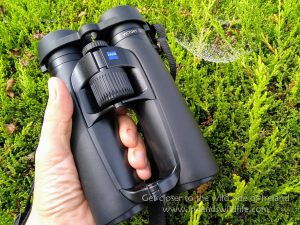 ZEISS has gone with a clever variation on the popular “open-bridge” dual-hinge design with the Victory SF. What’s different here is the location of the focus wheel, which is situated in the middle of the binocular’s top hinge. This essentially moves the wheel a few centimetres down the length of the instrument, and means that (when you’re holding the binocular “properly”) your index finger rest naturally on the wide, deeply knurled focus wheel without having to reach at an odd angle. It’s very comfortable.
ZEISS has gone with a clever variation on the popular “open-bridge” dual-hinge design with the Victory SF. What’s different here is the location of the focus wheel, which is situated in the middle of the binocular’s top hinge. This essentially moves the wheel a few centimetres down the length of the instrument, and means that (when you’re holding the binocular “properly”) your index finger rest naturally on the wide, deeply knurled focus wheel without having to reach at an odd angle. It’s very comfortable.
The focus knob itself is large, and turns smoothly, with pretty much ideal and consistent resistance throughout it’s travel of about 1.75 turns. There were reports of some “lag” in the focus wheel on the original (grey) version of the Victory SF. This latest (black) model exhibits no such trait, and focuses quickly and precisely from an impressive close focus of about 1.5 metres out to infinity.
The locking dioptre adjustment knob sits behind the focus knob on the face of the top hinge. You simply pull it out, turn to adjust between -4 and +4 dpt, and then push it back in to lock. The dial turns smoothly (no click-stop settings here) and there are gradations on the dial that allow you to note your setting and reset it easily should someone else borrow your binoculars.
It works well enough, but for me when the dial is pulled out for adjustment it feels a little flimsy, and not quite what I’d expect from a binocular of this calibre.
Eye-cups and eye relief
The eye-cups on the ZEISS Victory SF are, as you’d expect, of a twist-up design that’s common with most quality binoculars today. There are four possibly positions (fully up, fully down, and two intermediate click-stops) to choose from, with a maximum quoted eye relief of 18mm. That should mean most glasses wearers will have no trouble seeing the full extent of the impressively wide field of view through these binoculars.
The eye-cups screw on and off — which is handy for replacing them if they get damaged, or to remove them to more easily clean the ocular (eyepiece) lenses.
Which brings me to perhaps my biggest issue with the ZEISS Victory SF.
When I first twisted up the eye cups I had an “oh dear” moment. I couldn’t help feeling that they felt a little cheap and flimsy. They work well enough, and the rubber coating is very comfortable against your aye… but when I screwed off one of the eye-cups I discovered they are made of quite a maleable plastic, rather than the solid, leightweight metal alloy you’d expect in a binocular costing well in excess of €2,000.
Perhaps it’s some fancy polycarbonate compound that will outlast and outperform metal equivalents… but perception is everything, and it looks and feels like cheap plastic. Compared to the all-metal eye cups employed by the Victory SF’s contemporary competition, and even some entry level roof-prism models like the €280 Kite Caiman I reviewed recently (a binocular almost 10 times cheaper than the ZEISS), plastic eye-cups simply don’t cut the mustard do.
At this level details matter.
Weatherproofing
This hardly needs mentioning, but of course the ZEISS Victory SF is fully waterproof and nitrogen purged, so they’re impervious to the elements, dust, internal fogging and yes, even an unfortunate impromptu dip should you accidentally take a tumble into a stream while carrying them.
Optical Performance
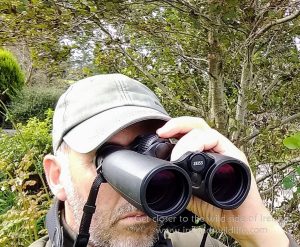 When you look through a pair of really high-end binoculars you want to be blown away by the view.
When you look through a pair of really high-end binoculars you want to be blown away by the view.
You pay a premium at the pinnacle of the optics market… and that’s about more than simply inflated brand prices and a misguided sense of kudos. There is a hint of that, sure, but it’s also about pushing the boundaries of performance beyond accepted limits, and selecting a complex blend of optical compromises to craft an unparalleled viewing experience for the user.
Image sharpness and field of view
I got that “Wow!” moment when I first looked through the Victory SF.
The first thing that strikes you is how bright and vivid it is… followed by an incredible sense of immersion provided by the extremely wide field of view, and an image that’s comfortably sharp all the way to the edge of that impressive field. At 120m / 100m (6.8 degrees) I occasionally had to pinch myself and remember I was looking through a 10x binocular rather than an 8x.
The Victory SF uses field flatteners in the eyepiece construction to eliminate distortion and deliver a crisp, high-resolution view right out to the edge. However, a completely distortion free field introduces a phenomenon known as the “globe” or “rolling ball” effect, causing the whole view to “roll” disconcertingly when you pan the binocular. It’s an affects some people notice more than others, and was widely reported and discussed when Swarovski Optik introduced a field flattener in their flagship EL Swarovision line. To counteract the rolling ball effect ZEISS has introduced a modicum of distortion as part of the optical design.
While the perception “rolling ball” is a personal thing, and not something that seems to bother me much, I have been able to detect it in other optics when i try. I didn’t really notice it with the Victory SF. Handheld in the field the view through the Victory SF appears razor sharp right to the very edge, with no noticeable rolling ball or discomfort when panning.
Hats off to ZEISS — this has to be one of the most impressive views through any binocular… period!
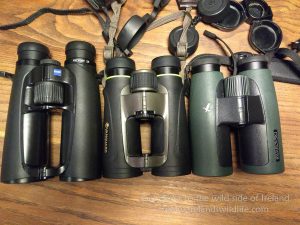
Colour fidelity, contrast and chromatic aberration
To my eyes colour rendition through the Victory SF is very natural and accurate. Contrast is excellent, delivering a vivid, realistic image that pretty much emulates what you’d see if you were standing ten times nearer with the naked eye.
It’s a very relaxed, comfortable… and, that word again… natural viewing experience.
ZEISS uses the highest quality glass from German glass manufacturer SCHOTT, including multiple fluoride-containing lenses in the optical design to virtually eliminate chromatic aberration (colour fringing) in the resulting image. It’s never apparent even when viewing high-contrast subjects in the field under normal conditions. As with any binocular you can induce colour fringing if you try really hard, but in normal use you won’t notice it.
Low light performance and coatings
The Victory SF has ZEISS’s proprietary suite of T* anti-reflective, high transmission coatings applied to all air-to glass surfaces. Combined with the use of phase corrected and super bright dielectric mirror coatings on the prisms they allow a remarkable 92% transmission for the optical system.
Bottom line… these are very bright binoculars that deliver crisp, clear viewing well into twilight and beyond. I could even use them comfortably for viewing by moonlight in the middle of the night. Low light performance is as good or better than any 10x binocular I have used.
They also take glare in their stride, and I noticed very few occasions where reflections or lens flare were an issue. Yes, unavoidably there’s some glare when you look almost directly into low evening or early morning sunlight — but again the Victory SF match or better any binocular I have used in this regard.
Last, but by no means least when it comes to coatings, is the LotuTec® coating. This is ZEISS’s aqua-phobic protective coating applied to the external lens surfaces. It serves to both repel dirt and water, which simply beads and rolls off — making binoculars more usable in extreme weather, but also crucially, making those expensive lenses easier to clean, and protecting the more fragile anti-reflective coatings beneath from undue wear.
Accessories
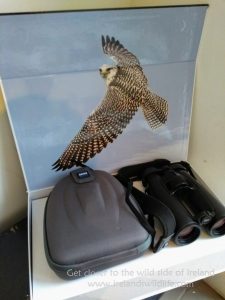 The ZEISS Victory SF comes with the usual suite of accessories you’d expect with a new high-quality binocular.
The ZEISS Victory SF comes with the usual suite of accessories you’d expect with a new high-quality binocular.
There’s a premium semi-rigid cordura case for storing your binoculars when they’re not in use (which if you’re like me is never — why would you keep your binoculars somewhere that makes them more difficult to access); a very comfortable branded neoprene neck-strap, a functional if slightly flimsy eyepiece rainguard, and an objective lens cover with a curious quick-release tether that has the cover dangling in the wind when in use (promptly removed — tethered objective covers of any kind are the work of the devil).
Warranty
ZEISS doesn’t seem to explicitly state a warranty period for the Victory SF on it’s UK or European product pages, but a quick phone call to the Zeiss UK customer service team reveals that they are covered by a 10 year warranty in Europe. In the USA and Canada, I guess to match other leading brands, they offer a lifetime transferrable warranty on the same binocular.
Conclusion
The ZEISS Victory SF is one of the finest binoculars on the market today.
The few minor foibles I mention in the review aside, this binocular delivers an astonishingly bright, crystal clear and thoroughly natural image across a class-leading field of view. Combine that with superb balance and ergonomics, and the binocular fades into the background when you’re using it. You’re simply immersed in the viewing experience.
That’s binocular nirvana… and along with very few others, the ZEISS Victory SF is pretty much as close to it as you can get.
You can buy the Zeiss Victory SF on Amazon.co.uk or on Amazon.com
Specification
Taken from the ZEISS UK website:
| Magnification | 10 x |
| Effective Lens Diameter | 42 mm |
| Exit Pupil Diameter | 4.2 mm |
| Twilight Factors | 20.5 |
| Field of View at 1000m | 120 m |
| Apparent Field of View | 65 ° |
| Close Focus | 1.5 m |
| Diopter Adjustment Range | +4 | -4 dpt |
| Pupil Distance | 55 – 76 mm |
| Eye Relief | 18 mm |
| Lens Type | Ultra-FL-Type |
| PrismSystem | Schmidt-Pechan |
| Water Resistance | 400 mbar |
| LotuTec® | Yes |
| Nitrogen Filling | yes |
| Functional Temperature in °C | -30 | +63 °C |
| Height | 173 mm |
| Width at an eye width of 65 mm |
125 mm |
| Weight in Use | 780 g |
| Order Number | 524224 |
Acknowledgement
I’d like to thank ZEISS UK for submitting the Victory SF 10×42 for review on Ireland’s Wildlife.
NB. Ireland’s Wildlife has no specific affiliation to any optics or gear manufacturer. All reviews on the site are completely independent and objective and carried out in accordance with our terms and conditions. If you’re an optics or gear manufacturer and would like to submit your product for review on the site please drop us a line using the contact form and we can take things from there.


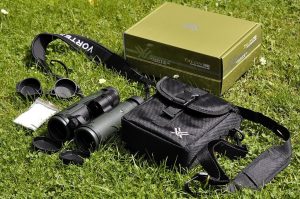






1 comment
Adam
Awesome review. Everything useful is here. I think I will get the Zeiss binoculars. Thank you.